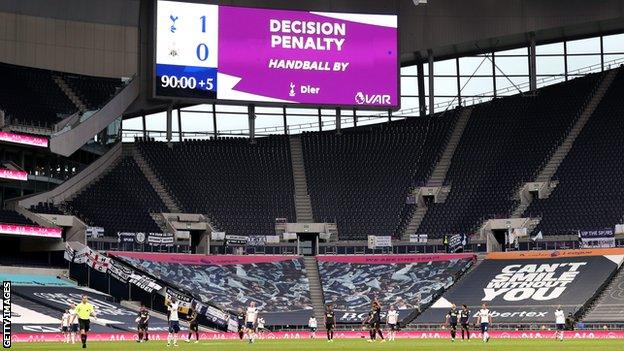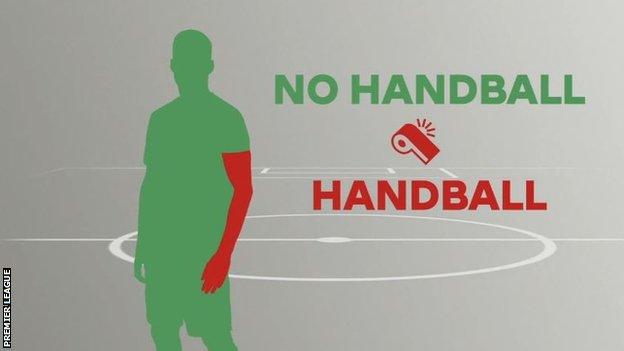Q&A: What is the new handball rule?
- Published

Tottenham's Eric Dier was penalised for handball under the new interpretation of the laws against Newcastle on Sunday
The new handball ruling has already caused plenty of controversy in the Premier League this season.
It has been called "nonsense" by Crystal Palace boss Roy Hodgson, who said it was "ruining the game", while Newcastle manager Steve Bruce says football has "lost the plot" with the new ruling.
So what is the new rule and what has changed?
What is the new law?
It's not technically "new" as it has been in force across Europe last season, but the Premier League is now taking a more strict approach. So that means a player will be penalised for handball if:
The hand/arm is clearly away from the body and outside the "body line".
The player clearly leans into the path of the ball.
The ball travels some distance.
The ball touches a hand/arm that is clearly raised above the shoulder.
The player falls and the hand/arm is extended laterally or vertically away from the body.
A deflection clearly makes no difference to the ball touching a hand/arm that is clearly extended away from the body and/or above the shoulder.
Immediately after touching the ball with the arm, even accidentally, the player scores a goal or creates a goal-scoring opportunity.
How has the handball rule changed?
Football's rulemakers, the International Football Association Board (Ifab), tightened up the handball rule in time for this season, defining the boundary between the shoulder and the arm as the bottom of the armpit.
Anything below that and it's a handball - intentional or not, it doesn't matter.
Ifab also emphasised a handball offence takes place when a player makes their body 'unnaturally bigger' and/or puts their arms above shoulder height.
It was also clarified that an "accidental" handball by an attacking player is only penalised if it occurs "immediately" before a goal or clear goal-scoring opportunity.

A Premier League graphic showing the handball rule
Has it resulted in more penalties?
Yes. There were 19 penalties for handball under the old rules in the Premier League last season, and at this stage last term there had been no penalties awarded for handball in the top flight.
Already this season there have been 20 penalties in the Premier League, 30% (six) of which have been for handball. Since the start of the 2006-07 season the highest percentage of handball penalties was 21.1% in 2008-09.
The average of 0.77 penalties per game (for any offence) so far in 2020-21 is also much higher than previous campaigns, with the next highest average 0.29 per game in 2006-07 and 2008-09.
In Europe, where the rules were strictly applied last season, the number of handballs rose from 37 to 57 in Serie A for 2019-20 and from 35 to 48 in La Liga.
In Germany, when they introduced the rule, their handballs went up, but last season they went down as players started to adjust.
Why are we seeing more handballs then?
For starters, VAR means referees are now having to judge incidents that they otherwise may have missed.
Fifa has taken over the implementation of VAR and ordered all leagues to apply strict interpretation of the rules in order to ensure consistency. This was mainly aimed at the Premier League as other leagues were already doing so.
Last season, the Premier League applied its own looser interpretation to some laws, including handball, the use of pitch-side monitors and goalkeepers encroaching off their line at penalties. This cannot now take place.
So should a penalty be given every time the ball hits a player's hand in the area?
No. The exceptions are if the ball hits a player's arm directly from the player's own head or body and if a player is falling and their arm is between themselves and the ground for support. There is also room for interpretation as to what makes a player's body 'unnaturally bigger'.
So, if a player has his arms by their side when the ball hits their hand/arm, they may not automatically concede a penalty.
Who makes the rules and can they be changed?
Ifab are in charge of the rules of the game and decide on any changes. Ifab is made up of representatives from each of the United Kingdom's football associations and governing body Fifa.
Each British association has one vote and Fifa has four. Any changes must be approved by three-quarters of the vote.